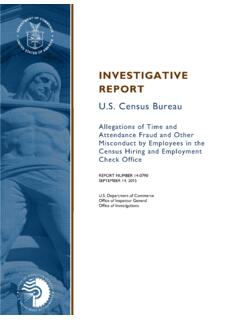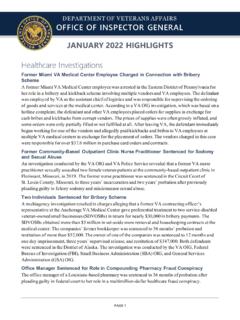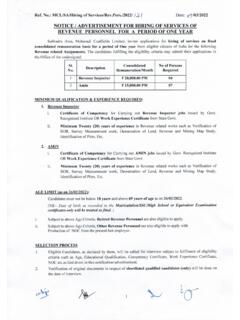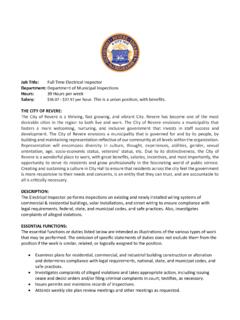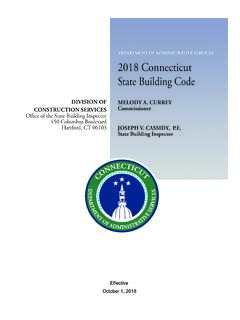Transcription of Department of the Treasury Office of Inspector General ...
1 1 DEPA RTM E N T O F THE TREA SURY W AS H I N G T ON, D . C . 2 0220 March 2, 2021 Office OF INS PECT OR G EN ER AL OIG-CA-20-028R Department of the Treasury Office of Inspector General Coronavirus Relief Fund Frequently Asked Questions Related to Reporting and Recordkeeping (Revised)1 The Department of the Treasury ( Treasury ) Office of Inspector General (OIG) is responsible for monitoring and oversight of the receipt, disbursement, and use of Coronavirus Relief Fund (CRF) payments as authorized by Title VI of the Social Security Act, as amended by Title V of Division A of the Coronavirus Aid, Relief, and Economic Security Act (CARES Act).
2 2 Treasury OIG was also assigned authority to recover funds in the event that it is determined a recipient of a CRF payment failed to comply with requirements of subsection 601(d) of the Social Security Act, as amended, (42 801(d)). Recipient reporting and record retention requirements are essential for the exercise of these responsibilities, including our conduct of audits and investigations. Beginning September 1, 2020, the prime recipient of CRF payments was required to report Coronavirus Disease 2019 (COVID-19) related costs incurred for the covered period from March 1, 2020 through December 30, 2020 in the GrantSolutions portal on a quarterly basis.
3 Since that time, the Consolidated Appropriations Act, 2021 extended the covered period for CRF recipients to use proceeds through December 31, Accordingly, the GrantSolutions quarterly reporting requirement has been extended through September 30, 2022 with final reporting by October 11, 2022. Each prime recipient must report COVID-19 related costs for the covered period of March 1, 2020 through December 31, 2021. This document addresses frequently asked questions (FAQ) from CRF prime recipients regarding their reporting and record keeping requirements and supplements Treasury OIG s memorandums Coronavirus Relief Fund Recipient Reporting and Record Retention Requirements (OIG-CA-20-021; July 2, 2020) 4 and Coronavirus Relief Fund Reporting Requirements Update (OIG-CA-20-025; July 31, 2020).
4 5 1 These FAQs haven been updated to reflect extension of the covered period for Coronavirus Relief Fund recipients to use proceeds March 1, 2020 through December 31, 2021, and replaces the previous revised FAQs dated November 25, 2020. 2 P. L. 116 136 (March 27, 2020). 3 P. L. 116-260 (December 27, 2020). 4 5 2 A. Prime Recipients 1. Who is a prime recipient? A prime recipient is an entity that received a CRF payment directly from Treasury in accordance with the CARES Act, including: All 50 States, Units of local governments with populations over 500,000 that submitted required certifications to Treasury , The District of Columbia, Territories, and Tribal Governments 2.
5 Who is a sub-recipient or a beneficiary? Treasury has provided guidance on the applicability of Single Audit and 2 Part 200, Subpart F in response to question of its Coronavirus Relief Fund Frequently Asked Questions (FAQs).6 According to Treasury s FAQ, the Single Audit Act and 2 Part 200, Subpart F regarding audit requirements apply to any non-federal entity, as defined in 2 , that receives payments from the Fund in the amount of $750,000 or more. Non-federal entities include sub-recipients of payments from the Fund, including recipients of transfers from a State, territory, local government, or tribal government that received a payment directly from Treasury .
6 However, sub-recipients would not include individuals and organizations ( , businesses, non-profits, or educational institutions) that are beneficiaries of an assistance program established using payments from the Fund. The Single Audit Act and 2 Part 200, Subpart F regarding audit requirements do not apply to beneficiaries. While the Treasury definition above is used for Single Audit Act purposes, Treasury OIG requires that the prime recipient report on both a beneficiary and a sub-recipient in the GrantSolutions portal.
7 Since there is no separate category to capture a beneficiary s data in the portal, the prime recipient must report on the beneficiary in the sub-recipient data fields. As such, for GrantSolutions reporting, a sub-recipient/beneficiary is any entity to which a prime recipient issues a contract, grant, loan, direct payment, or transfer to another government entity of $50,000 or more. 6 Treasury s FAQs were re-published in the Federal Register, dated January 15, 2021, and reflect the extension of the CRF covered period through December 31, 2021.
8 ( ). 3 3. The definition of a sub-recipient/beneficiary provided by Treasury OIG is different than the definition of a sub-recipient in the Office of Management and Budget s (OMB) Uniform Administrative Requirements, Cost Principles, and Audit Requirements for Federal, 2 CFR Part 200 (Uniform Guidance). Which definition is a prime recipient expected to comply with? The prime recipient must comply with both OMB s Uniform Guidance definition as it relates to the Single Audit Act and Treasury OIG s definition as it relates to reporting requirements for the GrantSolutions portal.
9 See question 2 above. 4. Who is responsible for reporting in the GrantSolutions portal, the prime or sub-recipient/beneficiary? Only the prime recipient is required to report COVID-19 related costs in the GrantSolutions portal. 5. If the prime recipient distributes funds to an agency or Department within the prime recipient s government, is the agency or Department considered the prime recipient or a sub-recipient when funds obligated are $50,000 or more? The agency or Department is considered part of the prime recipient as they are all part of the same legal entity that received a direct CRF payment from Treasury .
10 Obligations and expenditures that the agency or Department incurs with the CRF proceeds must be collected by and reported in the GrantSolutions portal by the prime recipient as if they were obligated or expended by the prime recipient. 6. If the prime recipient obligates funds to an entity that provides a public service on behalf of the prime recipient but the prime recipient is not financially accountable, is the entity considered the prime recipient or a sub-recipient/beneficiary when funds obligated are $50,000 or more ( , discreetly presented component unit, quasi agency, etc.)

